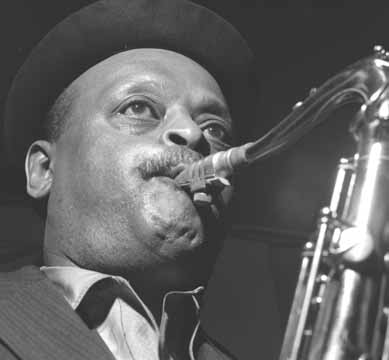Ben Webster, tenor saxophonist, was given the nickname “The Brute and the Beautiful”. His beautiful sound gave his ballads a touch of tenderness. He was also known for his fast tempo playing which was filled with growl and virile. When sober, he was kindest and most gentle man. However, he could be unpredictable and violent if he had consumed too much alcohol. He was loved by many, despite his Dr. Jekyll-Mr. Hyde personality. He recorded numerous excellent records, most of which are still in stock due to his status as the best-selling tenor saxophonist of jazz. Ben(jamin Francis) Webster, was born in Kansas City (MO) on March 27, 1909. He studied violin in elementary school and learned to play the piano by himself, inspired by Pete Johnson, a nearby living musician who also taught him the blues. He played in silent movies in Kansas City in 1927, but he left the city to join a small band in Texas. In 1928, he was back playing in silent movies again, this time in Amarillo. He met Budd Johnson, who showed him how to play a saxophone. Webster was so intrigued that he borrowed an alto saxophone. He left Amarillo in 1930 with Gene Coy’s Happy Black Aces. After a few months, Coy bought him his first tenor Saxophone. “I couldn’t express myself on alto,” he said. Webster’s career took rapid leaps forward after the tenor gave him a better sound. After Coy, Webster joined Jap Allen’s and Blanche Calloway’s bands, before becoming a member Bennie Moten’s important band. He also contributed fine solos to the band’s marathon recording session of December 1932. Webster was soon back in Kansas City, where he was hired by Andy Kirk. In June 1934, Webster went to New York to join Fletcher Henderson’s orchestra. He actually switched jobs with Lester Young, who then went on to Kirk. Webster spent the next few years with Benny Carter (1934), who saw Webster’s potential to be a ballad interpreter. He also worked with Willie Bryant (1935-196) and Cab Calloway (1936-1937), before rejoining Henderson in July 1937. After that, he joined Stuff Smith in New York. Webster was also a participant in a few small group recording sessions during these years, including those with Billie Holidaye and Teddy Wilson. What a little moonlight can do. He was a member Teddy Wilson’s big group and its most prominent soloist. But a dream was realized when he was offered a job with Duke Ellington’s orchestra. In January 1940, he left Wilson and moved to Boston to start his Ellington job. He had actually been a substitute for Barney Bigard twice, in 1935 and 1936. Webster stayed with Ellington from early August 1943 until his death. It was during this time that he achieved national and international fame through recordings such as Cotton Tail, Jack the Bear, Harlem Air Shaft and Sepia Panorama. Webster began his career as a Coleman Hawkins student. But, under Ellington’s influence, his style evolved and became more personal. His solos were fast paced and had a great rhytmic momentum. He also had a very raspy timbre and an almost aggressive aggression. While his ballad playing was sexy and breathy, and delivered one of the most beautiful sounds on a tenor Saxophone. Webster played in small groups after leaving Ellington. John Kirkby, 1944 in New York. He returned to Ellington in late 1948 for a brief year. After that, Webster went back to Kansas City to continue playing with Jay McShann, Bob Wilson, and Bus Moten. He spent 1952 in Los Angeles, where he recorded with various soloists and groups. Webster also freelancing with other soloists. Webster was a regular tourer with Jimmy Witherspoon around 1960. Webster toured in the fall of 1953 with Norman Granz’s Jazz at the Philharmonic. Granz was also instrumental in giving Webster an excellent recording contract, which gave Webster a boost with albums like King of the Tenors (1953), and Ben Webster Meets Oscar Peterson (59). Webster performed on the CBS TV broadcast The Sound of Jazz in December 1957. He was accompanied by Billie Holiday and Count Basie. The latter show saw him perform with Billie Holiday and Coleman Hawkins. It was the only time they ever played together. Fine and Mellow was a great performance by all, with Young being very emotional, Hawkins confident and Webster feeling intensely. Webster was not able to find work in New York in the 1960’s despite his excellent albums. He accepted an offer to play at Ronnie Scott’s Club, London in late 1964 and then sailed to England. Webster never returned the United States. After the London gig, Webster found work in Europe and flew to Scandinavia for a week. He settled in Amsterdam (1966-1969), and Copenhagen (1969-1969). He played in many clubs and festivals in Europe with local bands, or with visiting or expatriate musicians such as Bill Coleman, Don Byas or Teddy Wilson. His playing was unaffected by his declining health. Webster continued to play with passion and intensity until his final day. His ballad playing was tender and beautiful, almost laconic, and delivered every note with weight. Webster did not play ballads in double time as was common with tenor saxophonists of that era. He maintained the song’s feel throughout and kept the tempo at a slow pace. Webster was a unique jazz musician whose presence was evident on every record. Webster is considered one of the top three swing era tenor jazz saxophonists, alongside Coleman Hawkins (and Lester Young). Webster’s ballad playing and sound were a source of inspiration for many later saxophonists including Paul Gonsalves and Harold Ashby, Archie Shepp and Eddie “Lockjaw”, Davis, Frank Foster, Frank Foster, Sonny Rollins and Flip Phillips, John Coltrane and Scott Hamilton, as well as Branford Marsalis and Branford Marsalis. Charlie Ventura and David Murray modeled his rough-playing with growl on him, as did R.
